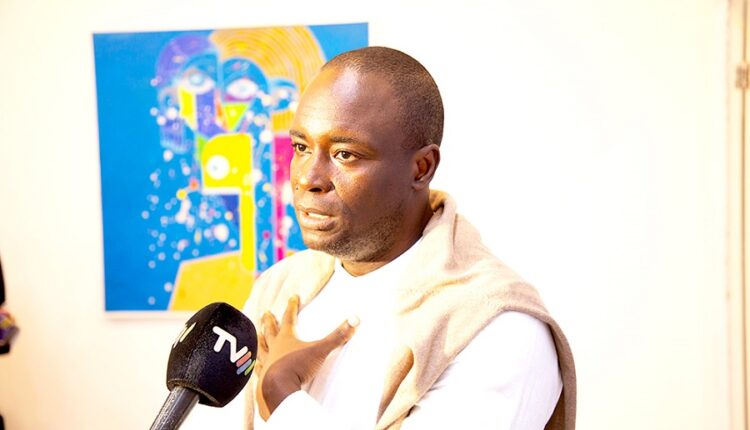
Mógas Unveils Pressures Between Identity and Aesthetics
Kinky Hair as a Mirror
By Leddo Luís | Lupa News
Some questions are not answered once and for all. They stretch across time, bodies, and memories, constantly demanding new perspectives. It is in this space of unease that artist Mógas launches his latest exhibition, “Identity and Aesthetic Ambivalences,” now on display at Galeria Arte de Gema.
Following two years of intensive research — including interviews, deep listening, and archival exploration — Mógas unveils a body of work that doesn’t just ask to be admired but challenges: What have we inherited in silence, and what do we choose to shout to the world?
 “I needed to map out what still carries symbolic identity for us Mozambicans. Hair emerged as a powerful thread in this conversation,” he explains.
“I needed to map out what still carries symbolic identity for us Mozambicans. Hair emerged as a powerful thread in this conversation,” he explains.
Central to the exhibition is kinky hair, explored not only as a physical trait but as a symbolic space inscribed with stories of resistance, pain, pride, and transformation. Each strand carries a layer of identity.
“Identity is never finished. It is a process of constant reflection,” says Mógas, inviting viewers to explore the visible and invisible layers that shape who we are and how we choose to show ourselves to the world.
“Talking about identity requires depth. We must dig into ourselves, question what we are — and what we need to discuss and reclaim, especially today.”
According to Mógas, kinky hair — at times marginalized, at other times celebrated — has long served as a marker of Black identity, present in both media and social discourse. At the same time, the influx of external beauty standards — from artificial hair to makeup — has intensified an identity conflict still evident in many women’s daily choices.
“That’s why we went back to the roots — 1974. We researched, observed, discussed, and only then began creating,” he says.
“We realised that for many women, looking ‘beautiful’ came at a high cost. Often, it wasn’t a free choice but a demand imposed by colonial history, globalisation, and overconsumption of imported aesthetics. We had to revisit the past to understand how we got here.”
Each piece in the exhibition is the result of meticulous creation, using pastel as the main technique — a deliberate aesthetic and symbolic choice to connect viewers to deeper layers of both the artwork and themselves.
Hair as Mirror and Protest
 The works confront tensions between what is natural and what has been imposed. The installation MIRA, for example, depicts a hairless body surrounded by hairdryers, raising questions about beauty standards and the pursuit of social acceptance.
The works confront tensions between what is natural and what has been imposed. The installation MIRA, for example, depicts a hairless body surrounded by hairdryers, raising questions about beauty standards and the pursuit of social acceptance.
“Some embrace their natural hair with pride, others reject it, and many have never even questioned it. In this exhibition, there’s everything — from the bold bald woman to those who can’t let go of extensions. I don’t judge — I simply hold up the mirror,” says Mógas.
For the artist, preserving identity in today’s world is not the responsibility of institutions alone, but of society as a whole. Education — both formal and community-based — is crucial.
“Education is the cornerstone. Then come the cultural expressions — language, music, theatre, cinema, poetry, visual arts. If identity isn’t anchored in memory, it fades. We must repeat, question, and keep it alive. Otherwise, we become mere agents of consumerism, vulnerable to external trends,” he warns.
Mógas sees himself not as a lone provocateur but as a mediator — someone who raises the conversation for others to continue.
“My role was to start the dialogue. Now it must be expanded, studied, written down, and preserved for future generations. This work is not finished. It’s a living document that must not be forgotten.”
Between Conviction and Ambivalence
For Mógas, aesthetics, identity, and resistance are inseparable. And they all converge in one word: conviction.
 “I always return to this word. Identity requires conviction. Aesthetic expression without conviction is shallow. Resistance, too, needs conviction. If I adopt a certain style, it means I’ve had the courage to own it — and that takes awareness.”
“I always return to this word. Identity requires conviction. Aesthetic expression without conviction is shallow. Resistance, too, needs conviction. If I adopt a certain style, it means I’ve had the courage to own it — and that takes awareness.”
To adopt an aesthetic is an act of courage. And true identity, the artist insists, only emerges through honest reflection on our choices and contradictions.
“We must reflect honestly on who we are, what we’ve inherited, and what we choose to reject. Only then can we truly preserve what is ours — unafraid of facing our own image in the mirror.”

